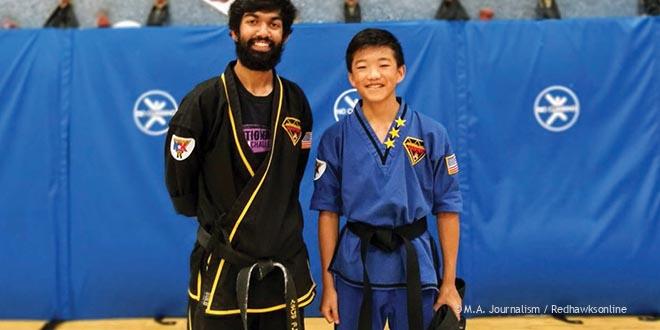Members of school community find that martial arts builds confidence, discipline
“As a woman, I do feel nervous walking around in public by myself sometimes, and just always being more aware and conscious of the people around me and their perceived intentions has helped me in a couple different situations,” said senior Izzy Peterson, who earned a green belt in tae kwon do when she was younger.
She is just one of the individuals in the Minnehaha community who have discovered many diverse benefits from practicing martial arts.
You may know Jeffrey Crafton, a sacred studies teacher at Minnehaha, but what you may not know is that he’s a black belt in tang soo do, a traditional Korean martial art with roots in China. Crafton started doing martial arts in 1997.
“Actually I did it because of my son,” he said. “My son was young and growing up, and he has some significant physical disabilities.” Crafton’s son, Nate, was interested in the sport but didn’t want to practice it alone.
Nate practiced the art in an adapted form through the Courage Center, a nationally-known not-for-profit rehabilitation and resource center for people with physical disabilities, brain injuries, speech or vision impairments or hearing loss. After almost five years of practice, Nate and Jeffrey Crafton both earned their black belts in tang soo do.
There are many life lessons you can learn from martial arts, Crafton said, such as “the value of hard work and sticking to something when you aren’t seeing the results right away, because it’s a slow process of learning. It’s easy to get frustrated and give up. Rather than keep going on, but I had to keep going on, and keep going on. I approached it when I was already an adult and so I had learned a lot of those lessons before, but this was more about reinforcing those lessons.”
According to a study done by Maine Martial Arts, 9.4 million adults, 5.5 million teenagers, and 3.2 million kids have taken some kind of martial arts class this past year. Martial arts also can help you learn to take risks.
Although there are many types of martial arts, some of the most popular are aikido, jiu-jitsu, judo, karate, kung fu, tae kwon do, which have their roots in East Asia. Growing in popularity are capoeira, which was developed by Brazilian slaves who disguised their training as a form of dance, and mixed martial arts, which has ancient roots and modern popularity through televised competitions on ESPN.
According to DefendYourself. org, self-defense teaches you the skills to use against harassment, abuse, and assault, including everyday situations that don’t involve a physical attack. Martial arts teaches awareness to help with prevention and may help develop the confidence to handle daily situations.
Daniel Ma, a freshman at Minnehaha, agreed that martial arts made him more confident by teaching him to defend himself. Ma started karate when he was only five years old, he said, because his mom wanted him to learn self-defense skills. She chose karate because a karate studio was conveniently located close to their house, but Daniel grew to love the sport.
“It’s been a part of me ever since,” he said, calling it a great form of self-defense. “One of the most important lessons you’ll learn from martial arts is courage. Knowing that you can defend yourself in a compromising situation will enable you to walk through life with confidence. If there’s something coming at me, I definitely have better reflexes.”
Another unexpected martial arts student is senior Izzy Peterson, who started martial arts in elementary school. She chose to take tae kwon do because her mom wanted her to learn some self-defense skills. She attended tae kwon do classes for almost four years and earned her green belt, which is level three in the sport.
“I think just learning self-defense from a young age encouraged me to always be aware and analyze certain situations and environments,” Peterson said. “For me, learning martial arts has helped while I’m at concerts, music festivals and even just walking around with friends in public. It’s super important to not space out when you’re in a public space and to observe the people and atmospheric conditions of your environment.”

